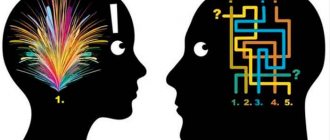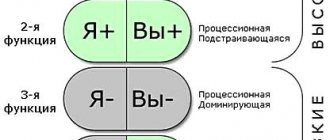- KtoNaNovenkogo
- FAQ
- Are you here
September 23, 2018
Hello, dear readers of the KtoNaNovenkogo.ru blog. Nowadays, many online services (especially those related to money in one way or another) have introduced the practice of undergoing identification (it is also sometimes called validation or verification, but this does not change the essence).
Identification may also be required when, for example, you want to restore the rights to your page in Contact (lost for some reason).
Well, in addition to the applied meaning, we will touch upon the question of what the word identification actually means, because it has quite a lot of meanings and is used in a variety of areas (not only those related to the Internet).
Description
Identification is distinguished from its more primitive analogue of introjection on the basis that identification to one degree or another is always conscious: although the process of identification itself remains unconscious, the choice of objects of identification is fully conscious and amenable to subjective control.
See also Empathy
As a defense mechanism
A defensive form of identification is the idea of someone as an extension of oneself. This is most common among parents who perceive their children in this way. On the one hand, identifying with them, the parent, as it were, ascribes to himself the youth and achievements of the child, and on the other hand, a projection of his own desires, goals and needs onto the child is usually added to this. This attitude towards others is especially characteristic of severe narcissism.
In addition, such a process as “identification with the aggressor,” although essentially more of an introjection of the aggressor, can be partially realized and then it is more correct to attribute it to a defensive form of identification.
As an adaptive process
Identification underlies normal attempts to become like another person or group of people, to adopt significant traits. In this form, it is present from early childhood and gradually develops from a primitive desire to “absorb into oneself” to more complex, effective and subjectively controlled forms. Identification promotes the establishment of a deep emotional connection with another person or group of people, a feeling of belonging, unity with them. Thus, not only character traits and characteristics can be adopted, but also norms, values, and patterns, which manifests itself in the form of conformism.
The adaptive power of identification can vary significantly, depending on who and when is chosen as the object of identification. Identification that increases socialization at one stage of life can reduce it at another: if at school age identification with a neighborhood brawler can help increase social status, then in adulthood the opposite effect is more likely.
Conscious and unconscious identification can make it possible to “stand in someone else’s shoes” - to be immersed, transported into the field, space, circumstances of another person, which contributes to a deep understanding of him.
Identification also underlies identity formation (Erik Erikson's concept).
Philosophy and psychology
Studying various processes in nature, as well as the worldview and mental experiences of a person, is a rather difficult matter.
In philosophy, it is often necessary to establish the identity of a known object with an unknown one, compare them and draw certain conclusions. Based on the scientific works of leading scientists in this field, the concept of personal identification was introduced. That is, a person’s attitude towards himself. Closely related to this concept is another one related to psychology and which is one of the types of psychological defense. This is the so-called projective identification. Its principle is that a person identifies himself with another person or group. Therefore, to the question: “Identify - what does this mean?” - you can give a specific answer. In most cases, this is to position yourself as a different person or perceive another person as your continuation. Most often, this is how parents perceive their child. In this case, adults believe that their offspring has fully adopted their own qualities, talents and, as a result, should desire and feel the same way as they do. Hence - music, drawing or sports classes that children hate, unnecessary gifts, misunderstanding of the interests of teenagers, that is, the problem of “fathers and children”. Thus, the meaning of the word “identify” in each individual area of life is original, different from all others. What is common in all cases is that the actions or objects performed are compared and either identified or not.
What is identification
I'll start right away from the end (or rather, from the beginning). What does this word mean from the point of view of etymology (linguistics). Everything here is both simple and complex at the same time. Simple, because identification is a test for sameness (similarity, identity), and identity is the final result of such a test (the conclusion drawn - identical or not).
It’s difficult because this word is used in very different areas, and its meaning may change as a result.
For example, identification in philosophy is a person’s awareness of his belonging to something (teaching, group, ideology). In forensic science, this is the identification of a person (by fingerprints, by voice, by handwriting, etc.). In the financial sector, this means checking the photo in your passport with your face.
In our computer age, this word is primarily associated with the information environment. Identification on the Internet is needed to understand that you are exactly the person you say you are. Most often, this is required by services related to money (payment systems, crypto exchanges), but other services may also require identity verification in order, for example, to restore lost access to them (social networks, email services).
A scan of a passport (or the passport itself shown in person) or another document is most often used as an identifier (confirming the identity of an object). As an identifier of your residential address, use a scan of a payment receipt where your address is indicated. And the code that is sent to you by email or phone, respectively, can serve as an identifier for your email address or mobile phone number.
For example, in Yandex Money I had to go through an identification process in order to be able to accept payments from some services to my wallet. You can work without it, but this way you will get significantly more opportunities and preferences.
To check your identity, you will have to present your passport at their office, or at a cell phone store that cooperates with them.
As I already mentioned, some services (such as social networks or email) have procedures for restoring access to lost accounts. For example, you forgot your password (or login) or worse, your account was hacked and your login password was changed. In this case, the service can restore your access, but to do this you will need to go through identification.
For example, if you have problems logging into VKontakte, you will need to go through the procedure for restoring access, which consists of identifying you (confirming your identity, i.e. identification - are you the same Vasya Pupkin or not). You will be asked to send your selfie against the background of a computer screen with the service page open:
They will also ask you to send a scan of your passport to check your identity and full name in your passport:
Why is biometric data collected?
Data collection has several very specific purposes in order to create the following.
Biometric passports and documents
These include:
- passports with digital photographs;
- passports with an inserted chip containing biometric information about its owner;
- documents with fingerprints (driver's license in some US states);
- plastic cards with a magnetic strip containing the owner’s biometrics.
Bank client databases
Banks collect biometric information about clients to give them unhindered access to banking resources:
- login;
- maintaining accounts and deposits;
- payment of loans and receipt of income on deposits;
- deposit and withdrawal of funds;
- work with salary projects.
In most cases, static biometric information – the client’s voice and his digital photograph – is sufficient for the bank.
Law Enforcement Information Systems
The biometric information collected can be static or dynamic. Static information in the form :
- fingerprints and palm prints;
- full-face and profile photographs against the background of a stadiometer;
- DNA samples in exceptional cases;
- voice test
digitized and stored in databases.
Dynamic information in the form:
- a person's gait recorded on video;
- digitized signature;
- digitized handwriting
is also entered into databases and is used to identify a criminal when searching for him or after his capture.
International systems for searching and eliminating individual terrorists or groups of terrorists
These systems involve collecting information before and after terrorist attacks:
- identifying the DNA of all people who were at the scene of a terrorist attack and comparing them with databases of national and international law enforcement agencies;
- obtaining biometric data after the death of suspected terrorists to identify their participation in previously committed crimes;
- receiving video from surveillance cameras;
- identification of suspected terrorists from photographs and videos obtained from various sources;
- collection of fingerprints for identification;
- collection of voice recordings with threats and their subsequent recognition;
- introduction of a biometric passport system in states most exposed to the threat of terrorism.
Systems for secure access to information resources
Typically, these systems use digital authentication in the form of logins and passwords. But in special cases can be used:
- initial biometric identification to enter client information into the database;
- remote biometric authentication with recognition of the client’s face, fingerprint or voice to log into the system;
- additional information on the behavioral nature of the actions performed by the client (the speed of typing characters on a computer keyboard, features of using the scroll wheel of a computer mouse, the client’s manner of holding and using a smartphone, etc.);
- the use of passive biometrics with machine learning in the process of finding a legitimate client on an information resource.
Safe access to closed systems for various purposes
Depending on the degree of protection of such a system, employee identity authentication is most often used based on the following criteria:
- digital image of the face and its individual elements;
- fingerprint;
- retinal pattern;
- anthropometric data obtained by scanning;
- express blood and DNA analysis.
Creation of repositories of state biometric information about its citizens
The most economically developed countries in the world, having sufficient resources and caring about their citizens, have the opportunity to create such storage facilities for the purpose of:
- preventing internal and external terrorist threats;
- instant identification of any person in an extreme situation;
- collection of targeted statistical data;
- simplification of voting procedures in elections at various levels;
- simplifying the authentication of a person when accessing internal resources for government services;
- receiving targeted support from the state;
- opportunities for simplified travel abroad.
Internet identification and anonymity
For now, the Internet can be considered at least partly anonymous. If anything happens, of course, they will still find you, but this requires serious effort (calculating the IP address, etc.). But I think that in the near future (decade) it will be difficult for unidentified users to enter the network.
Everything is moving towards this and to some extent this is correct. It’s as if this doesn’t restrict your freedom very much, but on the other hand, there will be an order of magnitude fewer Internet hooligans (such as haters or trolls).
This does not mean that everyone you meet will be able to find out your full name or address. It’s just that Internet providers will clearly and easily identify you, which will somewhat cool down hotheads who draw parallels between anonymity and permissiveness. IMHO (what is it)
Good luck to you! See you soon on the blog pages KtoNaNovenkogo.ru
* By clicking on the “Subscribe” button you agree to the privacy policy.
Collections by topic
- Questions and answers
- I use it to earn money
- Useful online services
- Description of useful programs
I use it to earn money
- WorkZilla - remote work for everyone
- MiraLinks - pay for posting articles
- GoGetLinks - website monetization
- Questionnaire - they pay for passing tests
- Etxt - pay for writing texts
- Qukoment - comment exchange
- Finding the best exchange rate
- 60sec - profitable cryptocurrency exchange
- MyOpinion - bonuses for completing surveys
- Binance - a reliable cryptocurrency exchange
- VkTarget - earnings in social networks (VK, OK, FB, etc.)
Category: Answering frequently asked questions
Identification is the likening of a person to another individual, group or fictional character. Identification is a defense mechanism of the psyche, which is contained in the unconscious identification with an object, which causes anxiety or fear. Identification is translated from Lat. in the language “identificare”, as identification, the root “iden” means something that does not change for a long time. Given this definition, we can formulate the concept of identification as the similarity or correspondence of something to an existing sample, taken as a basis, having designated stable parameters. The mental defense mechanism can be situational, unconscious, in which a person likens himself to a specific other significant person, as a model. The basis of this similarity is the emotional connection between people.
Types of identification
Identity in the narrow sense is the identification of a person with other people. There are primary and secondary identification. The primary one is the identification of the baby first with the mother, then with the parent whose gender corresponds to the child. The secondary one occurs a little later with people who are not parents.
When identifying with a fictional character (from literature, a film), insight into the meaning of the work of art itself occurs, in which the individual begins to experience aesthetically.
The identification mechanism begins to operate actively from childhood. The child gradually develops similar traits and stereotypes of actions, value orientations, and sexual identity matures.
Situational identification often manifests itself in children's games. Situational identification examples: identification of a child with his parents, loved one, brother (sister). This identification is expressed in an intense desire to become like a significant person.
Group identification is a person’s stable likening to a community and a group; it is reflected in the acceptance of the goals and values of the group as one’s own; understanding oneself as a member of a group. The described concept is often found in engineering, legal, and criminal psychology, and serves as identification, recognition of some objects (people), assignment of these objects to a specific class, or recognition through comparison of known features.
Social identification reflects the process of classification, perception, evaluation, and personality of oneself as an agent who occupies a specific position in the social circle. It is a way of understanding one’s own belonging to social groups. The identification of a person as a biological individual with social groups makes him precisely a social person and an active personality, which allows him to evaluate personal social connections and use the term of belonging “We”.
Personal identification is a set of traits that are distinguished by their constancy and allow one to differentiate a particular person from other individuals. Personal identification refers to a set of characteristics that makes a person similar to himself and distinctive from others.
Personal identification (Self-identity) represents the unity and constancy of life-meaning attitudes, motives, goals of life of an individual who understands himself as a subject of active activity. It is also not a set of special traits, or a special quality that a person possesses. This is the person's self (true essence). It manifests itself in a person’s actions, in the reactions of others to him, and most of all in his ability to understand and maintain the history of his personal “I.”
Types of identification also include ethnic identification. Ethnic is one of the most stable types of social identification. It is designated as the emotional result of the cognitive process of self-determination of an individual or a small group in social space, characterized by an understanding of personal belonging to an ethnic culture, as well as an understanding, experience and assessment of one’s position.
Political identification is the identification of an individual with a specific life position. It is expressed as the unity of attitudes and orientations of a political subject, the coincidence of ways to achieve political goals, arises from the acceptance of political roles and the emotional relationship of the individual with political force.
Political identification is an attitude toward political leaders, institutions of power, and various issues related to politics.
Formation of self-identity
According to E. Erikson’s theory, the formation of a person’s self-identification is the result of resolving age-related crises:
- Year 1 crisis. At this age, the baby is trying to understand whether the world around him can be trusted.
- Crisis 3 years. At this stage, the will is formed, the child seeks an answer to the question of whether he can regulate his own behavior.
- Crisis 6 years. A crisis of self-identification in which there is a confrontation between initiative and guilt. The little person is trying to find out if he can not depend on his parents and independently discover his own capabilities and abilities.
- Crisis 12 years. With favorable development, the child develops and develops self-confidence; at this stage, he seeks and finds the answer to the question of what he is capable of and what he can do.
- Crisis of 19 years. This is a period of self-discovery: a person tries to learn as much as possible about himself, connects to various social groups in order to understand what he is like.
- Crisis 23 years. At this time, love and romantic relationships come first; a person is looking for an answer to the question of whether he is capable of love and what he is ready to do to create and maintain relationships.
- Middle age crisis. At this stage, the person searches for the meaning of his life and conducts the first serious analysis of his life goals and determines the stages passed in achieving them. Self-identification continues at the value and spiritual level.
- Crisis of old age. A person analyzes his life, trying to understand whether there was meaning in it and what were the achievements throughout his life.
What is identification
The definition of identification is the deep-seated need of the individual to establish coincidences and similarities with the object of veneration. A person who perceives the world as a system of mysterious phenomena and things becomes unable to independently understand the meaning of existence and the purpose of the world around him. Such a person needs a stable orientation system that would enable him to compare himself with a specific model. A mechanism of this kind was first developed in the psychoanalytic theory of Sigmund Freud. He identified it based on personal observation of pathological cases, and later extended it to the “healthy” spiritual life.
Sigmund Freud considered the identification mechanism as an attempt by a weak person (or a child) to adopt the strength of significant other individuals who are authorities for him. Thus, the individual’s anxiety and sense of fear of reality decreases. It has been established that the individual has a deep-seated need to constantly observe personalized samples in his field of vision. Applied psychoanalysis also studies the types of identification mechanisms associated with the organization of various social movements and the manifestation of the charisma of political leaders.
There are some identification methods that are used in different spheres of life (psychology, criminology, medicine).
Identification methods include the study of such biometric indicators: fingerprints, face shape, retinal pattern, iris, uniqueness of voice, originality of handwriting and signature, “keyboard” handwriting, etc.
Identification methods are divided into static and dynamic techniques. Static - formed on unique human properties, given from birth, not separate from the body. These are physiological properties - palm pattern, facial geometry, retinal pattern, etc.
Dynamic - based on the dynamic (behavioral) characteristics of the individual. Behavioral characteristics are manifested in subconscious movements carried out by a person - speech, typing dynamics, handwriting. These dynamic characteristics are influenced by controllable and less controllable psychological factors. Due to variability, biometric samples must be updated when used.
One of the popular methods is fingerprinting. Fingerprinting is based on the originality of the papillary patterns of each person's fingers. A special scanner acquires the outline of a fingerprint, which can be correlated with existing fingerprints in the database and identify a person. Another static method is identification by hand shape. To do this, measure the shape of the brush. Identification based on the uniqueness of the iris and the pattern of the retina is performed with a special scanner that is harmless to vision.
Creating a 2/3D face is also a static method. Using a camera and a special program, facial features (contours of lips, nose, eyes, eyebrows, etc.) are highlighted. The distance between these indicators and other parameters are calculated. Based on the information received, an image of the individual’s face is formed.
The dynamic method is to identify a person based on the characteristics of his signature and handwriting. In this method, the main thing is the stability of the uniqueness of each person’s handwriting (pen pressure, curls, volume, etc.). The handwriting characteristics are examined, then processed into a digital image and processed by a computer program.
Another dynamic method is recognition by the dynamics of typing using keyboard keys (“keyboard handwriting”). The process is similar to the handwriting recognition method. However, here a keyboard is used instead of paper, and a certain code word is used instead of a signature. The main characteristic is the dynamics of the computer typing of this code word.
The voice recognition method is a method that is very convenient in its application. It began to be used due to the widespread use of telephone connections and various gadgets with microphones. The problem with this method is the factors that affect the quality of voice recognition: noise, interference, errors in pronunciation, uneven emotional state, etc.
Identification concept
Identification is a mechanism, the basic basis for the functioning of which is the emotional contact of a person with the people around him (parents), which leads to an unconscious assimilation to them.
This is the identification of personal character traits, one’s own feelings, thoughts, external data with similar characteristics of other individuals.
Types of identification
Identification can be divided into several types, depending on the field of activity or its application.
- Personal. Detection and preservation of an unchangeable personal principle.
If a person is able to draw a parallel between this permanent core and his own person, then he is destined not to get lost in the plurality of roles he plays.
- Social. A citizen identifies himself with representatives of a specific group of people, taking into account his social sympathies, life hobbies and common problems.
The reason for the need for social identification is a person’s deep-seated need for self-realization, recognition from others, receiving approval from society and collective protection. By identifying his individual with specific communities, a person can explain “why does he consider this particular group to be his?”
- Unconscious. This type of identity is determined by the following criteria: considering himself a member of a certain group, a citizen, at the same time, demonstrates qualities that characterize representatives of another society.
- Partial. The manifestation of this type of identity is possible with multi-group membership.
In this case, a person perceives himself as a representative of several groups (professional, sports, family).
- Direct. The implementation of this kind of identity occurs through a society close to the one to which the citizen subjectively identifies himself, although for some reason he does not belong to it.
- Language. The distinctive features of languages have become a reflection of significant differences between the cultures of peoples.
Differences in behavior and language may appear when in contact with citizens of different status, or representing an external or internal group of a person.
Under the influence of culture, the social context of the use of certain words changes. For example, peoples whose language provides for the absence of the pronoun “I” when speaking, as a rule, are distinguished by greater collectivization.
- Political. The socio-political basis of this type of identity implies several possible interpretations.
For example, the basis for the emergence of its ideological subtype is the cognitive components of consciousness, that is, it is a construct that reflects the socio-political worldviews, interests and aspirations of citizens.
Such identity becomes the basis for the formation of political beliefs and consolidation of the community.
- By religion. Religious affiliation directly influences the formation of national identity, namely, the definition of the ethnic group to which an individual belongs.
People, being Catholics, Orthodox, and Muslims, focus on their own belonging to a particular ethnic culture. Accordingly, religious identification replaces ethnic identification.
- According to biometric parameters. The basis for this type of identification of a citizen is his unique physiological and behavioral characteristics.
Its use is aimed at preventing access to the territory of a closed institution, to an ATM or computer.
Biometric properties are presented:
- facial geometry,
- fingerprints,
- iris,
- handwriting.
With the development of technology, new parameters appear.
- By DNA analysis. The objects for such analysis are DNA regions characterized by repeats in their own sequence.
- Based on appearance. Identification of this species solves problems associated with operational-search activities (identification of persons hiding from the law or missing, identification of individuals using verbally recorded or photographic images).
- By dental status. The need for this type of identification arises when unidentified corpses are discovered, that is, if it is not possible to identify the deceased by appearance.
- Banking. During transactions, the client is required by law to present a passport (this can also be identification documents: a military ID card, or an identity card temporarily issued to a citizen by internal affairs bodies).
- Legal basis.
It is divided:
- procedural, the reason for this type of identification is the criminal procedure code;
- not procedural, the reason for its implementation is operational investigative actions and compilation of forensic accounts;
- carried out by subjects;
- carried out according to the nature of the images (the image remaining in the memory of a witness or acquaintance;
- carried out based on evidentiary value (when it is established that some characteristic belongs to a specific person, for example, handprints or smell).
Identification in psychology
This concept in psychology describes a process where a person is partially or completely dissimilated (rejected) from himself. A person's unconscious projection of his own personality onto what and who he really is not: another person, a matter, an object, a location. This is identification, unconscious assimilation with another person, ideal, group, phenomenon, process.
Identification is an important part of normal personality formation.
Identification examples: identification of a child with his father, which means assimilation of his way of thinking and stereotypes of action, or identification of siblings who exchange information, constantly interact, as if separately they were not individuals.
Identification may be confused with imitation. However, it is distinctive because imitation is a purely conscious imitation of another person, and identification is unconscious. It promotes the development of man until his individual path is laid out. When a better opportunity arises, it reveals a pathological character and subsequently leads to a suspension of development, although before that it contributed to development. This mechanism promotes personality dissociation, that is, the splitting of the subject into two personalities alien to each other.
Identification concerns not only subjects alone, but also objects, phenomena, and psychological functions. The identification of psychological functions leads to the creation of a secondary character; the individual identifies himself so much with his most developed function that he moves greatly away from the initial bias of his own character, as a result of which true individuality passes into the unconscious.
A similar outcome is regular in individuals with a developed primary (leading) function. This has some significance on the path of individualization of a person. The child's resemblance to the closest family members is partly normal because it is consistent with the original family identity. Here it is more appropriate to talk about identity rather than identification.
Identification with loved ones, unlike identity, is not an a priori fact, but is formed secondary in a subsequent process. An individual, starting from the initial family identity, on the path of personal development and adaptation encounters obstacles that require efforts to overcome them, as a result, stagnation of libido (vital energy) is formed, which begins to search for a path to regression. Regression allows one to return to previous states and to family identity. On this path, any identification is formed, it has its own goal - to comprehend the way of thinking and stereotypes of action of another subject, in order to achieve a certain benefit or eliminate some obstacle, solve a problem.
Collectivist identification manifests itself in collective activity, when the experiences of one group member are offered to others as motives of behavior that form their common activity. This means unity of motivation and the formation of relationships based on moral principles. It is most expressed in complicity and sympathy when a group member responds emotionally to the successes, happiness or sorrows of everyone. Collectivist identification is expressed through the recognition of equal obligations for oneself and others, manifested in the provision of support and participation, and the demanding attitude of others towards oneself.
The psychological basis of collectivist identification is the individual readiness to act in collective activities, to experience, to feel others as oneself. This phenomenon prevails in the group of significant development, without paying special attention to the personal preferences of team members. Manifestations of collectivist identification, mediated by value orientations of joint activities and semantic attitudes, become stable characteristics of each member of the team and cease to be dependent on subjective sympathies.
Collectivist identification arises around preschool and school age when children cooperate with each other.
Narcissistic identification manifests self-projection onto the “I” as a lost subject if the detached libido is oriented towards the “I”, while the individual treats the personal “I” as an abandoned object and directs ambivalent impulses towards it, which, among others, include aggressive components.
Gender identification expresses the integrity of the behavior and self-awareness of an individual, who identifies himself as one of the genders, and is guided by the requirements corresponding to his gender.
Gender identification expresses one aspect of gender, which is defined as a person’s self-identification with a specific gender, as a sense of self as a woman, a man, or an intermediate state. It is worth remembering that gender identity will often, but not always, correspond to biological sex. Thus, a woman brought up in a certain environment may feel more like a man, and vice versa.
General characteristics of the identification process. Stages of identification research
Identification of an object means establishing (revealing) its identity with itself in different periods of time or in its different states using for these purposes the reflections left by it.
Forensic identification is the process of establishing the identity of an object through a comparative study of the group affiliation of specific objects in order to obtain evidence related to a specific crime committed.
Basic conditions for forensic identification:
• individual certainty of objects;
• presence of stable signs characterizing them;
• identification by displaying these features;
• use of identification in forensic case study.
Forensic identification is carried out both in procedural (expert, investigative, judicial) and non-procedural (during preliminary examination of objects, checks on records, during operational-search activities) forms.
Identification research includes several stages:
1. separate research - identifying the largest number of identification features of each of the compared objects, studying its identification field.
2. comparative research - comparison of the identified identification features inherent in each object, and the establishment of similar and different ones.
3. formulating a conclusion about the presence or absence of identity.
The result of forensic identification can be:
• establishing the presence of identity;
• establishing the absence of identity;
• conclusion about the impossibility of solving the identification problem.











